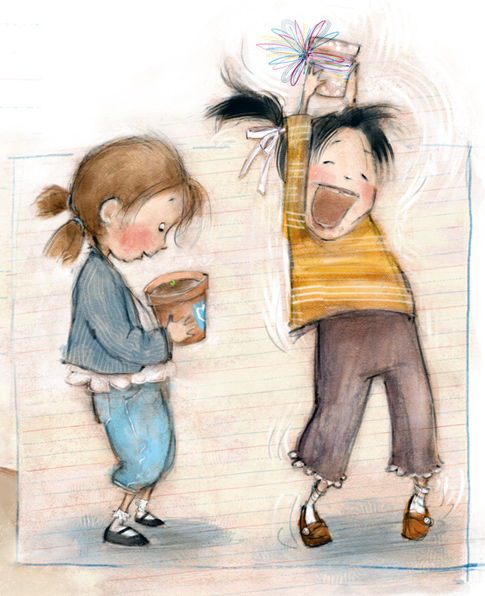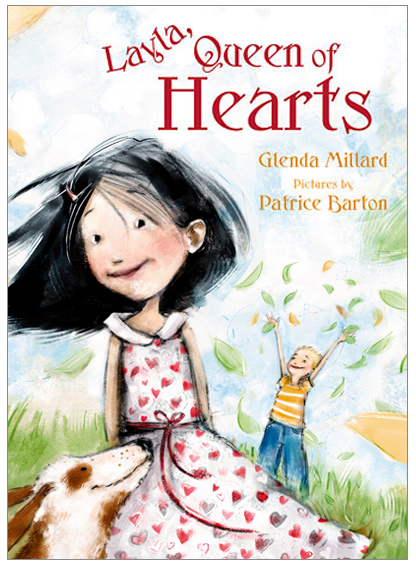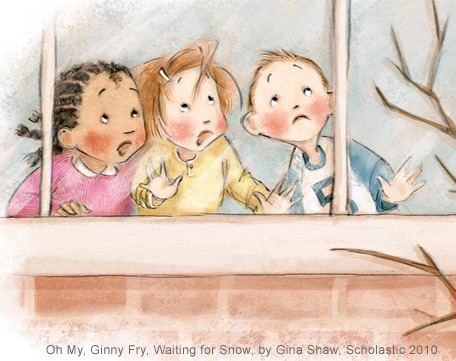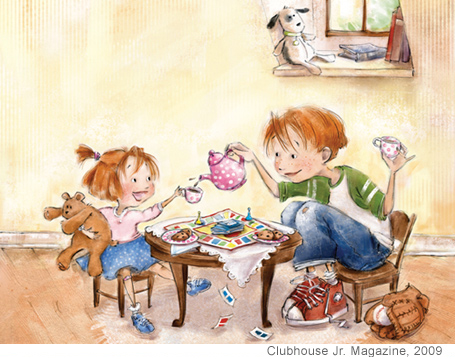 Patrice Barton says her artistic talents were first discovered at the age of three, when she was found creating a mural on the dining room wall with a pastry brush and a can of Crisco. Although the work itself was never fully appreciated by her parents, her interest in art was. They quickly gave her a better canvas and more appropriate supplies. Her passion for art grew, and she earned a BFA in Studio Art from the University of Texas in Austin, where she now lives with her husband and son, a few doggies and one can of Crisco (for cooking only).
Patrice Barton says her artistic talents were first discovered at the age of three, when she was found creating a mural on the dining room wall with a pastry brush and a can of Crisco. Although the work itself was never fully appreciated by her parents, her interest in art was. They quickly gave her a better canvas and more appropriate supplies. Her passion for art grew, and she earned a BFA in Studio Art from the University of Texas in Austin, where she now lives with her husband and son, a few doggies and one can of Crisco (for cooking only).
Patrice tells a little about her process using her new book MINE to walk you through.

I read the manuscript over and over- even when it only has only two words, if you count “Woof”.

When I was ready to sketch, I began this book by plastering my studio wall with baby photos… of my son, my nieces and nephews… my friend and fellow illustrator Laura Logan emailed me pictures of her infant daughter’s hands and feet. Then I started sketching babies in all positions to try and get a feel for them. I just played, sketching dozens and dozens of babies.

I kept reading the manuscript and started working up thumbnail sketches using tracing paper and a number 2B pencil. With tracing paper, I can layer the sketches and see through a bit to make changes.

Then I fleshed out the thumbnails and made little dummy books (step2). These were small, around 4 inches square. When satisfied with the layout and page flow, I sketched out the first roughs and scanned them into my computer. I sized them in photoshop, then added shading/value in Painter.

I kept printing them out and gluing them into my dummy to see if the pacing, page turns and gestures were working. When I’m happy with them, I send this version to my art director for approval. The final art is completed in Painter.

I scan in bits of canvas that I have painted and textured, papers I like that have nice grain and I play with them in photoshop using layering and effects to find a nice background to paint on.

In Painter I work in layers, with the pencil lines on one layer, clothing and hair on another, etc. That way I can make changes a bit easier.

For example on the MINE (illustration below), I changed the shape of the baby’s face. Since the line art was on a separate layer, it was easy enough to do even with the art almost finished.

Then Final Art.

You can see the little dummy in the sketches below.

Final Art

I asked Patrice a few questions. Here is the exchange:
QUESTION: When did you get you first contract for a picture book? What was the title?
My first picture book contract was in 2005 with QEB Publishing for a series of four picture books. The series, by Annette Aubrey, was called “Understanding” and was designed to help young children deal with new, bewildering, or upsetting situations that may be affecting them or those around them. The titles are: A Place in My Heart… understanding loss, There For You… understanding divorce, The Rainbow Club… understanding bullying, and Flora’s Family… understanding adoption. (Illustration from A Place in My Heart (below).

QUESTION: How did that job come about?
The publisher contacted my agent Christina Tugeau.

QUESTION: Had you done other types of illustrations and art before this?
Yes, for years I was employed as an illustrator for the State of Texas. Part of my job entailed working on courtroom displays for the Texas Rangers, the Attorney General’s Office, and any other police agency in Texas that needed them. This included visiting crime scenes, studying crime scene photos, reading case files, then drawing and designing posters or building models for the courtroom. Although this might sound intriguing to some, I realized I was not exactly CSI material. My most satisfying days were the ones I worked on artwork for children (coloring books on safety precautions, bicycle safety campaigns, trading cards for the drug sniffing dogs and their Troopers to hand out on school visits.) As it happened, the coloring books and posters I designed for children attracted my first freelance clients. So, by day I worked on displays of fingerprints, blood splatters and crime scenes and at night at home, I freelanced illustrating for the children’s market. After several years of building freelance clients (and a tidy savings account), I took a leap of faith, left the security of my day job and went full time freelance. I signed up for a local SCBWI conference, had a wonderful time, started meeting other children’s illustrators/writers, studied the industry, gathered a few more clients, signed with my agent and I haven’t looked back.

QUESTION: How long does it normally take to finish a picture book?
As much time as the publisher gives me! 🙂 For me, it averages 6 or 7 months from signing the contract to turning in the final art.

QUESTION: Did you take any lessons to help you use Painter and or Photoshop?
I taught myself Painter, using the program’s tutorials and a Painter Wow! handbook. To learn Photoshop, I took a course at our local community college.

QUESTION: What books have you illustrated?
Recent Books:
MINE! by Shutta Crum, Knopf 2011, 4 starred reviews
Sweet Moon Baby by Karen Henry Clark, Knopf 2010
The Looking Book by P.K. Hallinan, Ideals Publishing 2009
Layla, Queen of Hearts, by Glenda Millard, Farrar, Straus and Giroux 2010
The Naming of Tishkin Silk, by Glenda Millard, Farrar, Straus and Giroux 2009
Coming Soon:
Rosie Sprout’s Time to Shine, by Allison Wortche, Knopf December 2011
I Like Old Clothes, by Mary Ann Hoberman, Knopf 2012

QUESTION: Have you illustrated picture books besides the ones you listed?
No, those listed and the QEB series are it – so far! I do have a series of 3 chapter books with Scholastic Book Club, “Oh My Ginny Fry!” by Gina Shaw. They are first grade reading level, 48 pages with colored illustrations on each page. They are sort of a bridge between picture and chapter books. I really enjoyed illustrating them! (Cover art from Oh My Ginny Fry above.)

QUESTION: Before you started painting digitally, what materials did you use when illustrating?
Traditionally, I used watercolor and colored pencil. For grayscale art, I used ink on vellum or 2B pencil on vellum.

QUESTION: Do you ever draw directly into the computer with a drawing tablet?
Oh yes, using a Wacom tablet. Some art is done completely on the computer, other times I scan in my rough sketches and begin there.

QUESTION: Do you feel you have a style and if so, what would you call it?
My approach to style is that I view it as a process, not an end result. I keep an open mind-set with each new project so I can stretch and grow.

QUESTION: I plan to share the video your rep. Christina Tugeau showed me with week with everyone as soon as you get permission. How did that come about?
Mark Mitchell (http://howtobeachildrensbookillustrator.wordpress.com/ ), the interviewer, is a friend of mine from Austin SCBWI. He is an award winning published authour/illustrator and currently, the Illustrator Chair for our chapter. Also, Mark teaches classes in children’s book illustration at the Art School of the Austin Museum of Art (http://www.amoa.org/site/PageServer?pagename=art_theartschool ) and through his online course Make Your Splashes – Make Your Marks! (http://howtobeachildrensbookillustrator.wordpress.com/courses/ ) The course includes in-depth video interviews with working children’s book artists. Mark was kind enough to invite me to participate.

QUESTION: Do you do any self promotion or do you leave all that sales and marketing up to Christina?
Christina does a fabulous marketing job for us, with several mailings a year and trips to New York to visit publishers, to name a just a few of her efforts. I do have postcards and bookmarks printed to have as takeaways at events like conferences or school visits. Also I have an online presence with my website, blog and several online portfolios.

QUESTION: Do you work everyday on illustrating?
When I have deadlines, yes. When I am between deadlines I work on personal projects and also use the time to explore new materials – like collage, paper making, whittling. I also use off days to catch up on the business end of illustrating – backing up files, updating software, organizing.

QUESTION: Have you gotten to the point where you are so busy that you have to turn things down? Or do you just kill yourself to make sure you get the job.
I have had the painful experience of turning down jobs because I was too busy. Sometimes, clients can put projects on hold until you are open, but often they cannot. My loss will become another illustrator’s opportunity, so that’s good for them! I already had a full plate, so no complaints.
If I take on more work than I can handle, the quality of all my projects will suffer. I am not willing to go there. That would not be fair to my clients and the projects I am working on.

QUESTION: Have you ever looked at a text and felt like you didn’t connect with the text?
Yes, I have. When that happens, I’m not the right illustrator for the job.

QUESTION: Do you have any tips for the illustrators reading this about how to get their foot in the door and get themselves noticed?
I would start with building a strong portfolio. Target the market you most want to work in, include the style of work you enjoy doing most, be true to yourself and make sure your style shows who you are, include only your very best pieces. Also, have an online presence where editors and art directors can easily view your work. Explore SCBWI and take advantage of all it has to offer.
When it comes to your artwork, try everything! Enjoy! Play! Dig in! Go out on a limb! If you go too far, you can always reel it in a bit. If you don’t stretch, you won’t know how far you can go.

Thank you Patrice for sharing your illustrations and process. I loved seeing MINE develop and it was fun to see the illustrations for Rosie Sprout’s Time to Shine, by Allison Wortche, Knopf December 2011. We love Allison in New Jersey, so now that we know you, it is a definite book to buy.
Please visit Patrice at www.patricebarton.com to see more of her work.
Talk tomorrow,
Kathy
I SO thoroughly enjoyed this interview and the illustrations from beginning to end. Kathy, you asked Patrice what her style was. If I had to describe it, I would say “soft, warm and welcoming” because that how each picture made me feel. This is wonderful stuff! Thank you SO much for sharing this, Patrice and Kathy! 🙂
Donnas
LikeLiked by 1 person
By: :Donna Marie on July 30, 2011
at 2:26 am
Donna,
I agree. Patrice’s illustrations make me smile. I swear everyone should put a dog or baby in their illustrations, because everyone loves to see them in a picture. She did a fabulous job with them.
Kathy
LikeLiked by 1 person
By: kathytemean on July 31, 2011
at 12:35 am
Donna,
Thanks so much for the kind words about my work!
Kathy,
Thank you so much for the opportunity to share my work and process with your readers. Very fun! And I agree with you – there can never be too many babies or puppies in any illustration! 🙂
LikeLiked by 1 person
By: patrice on August 3, 2011
at 12:39 pm
Great interview Patty!! Your work just shines.
LikeLiked by 1 person
By: marshariti on August 5, 2011
at 11:02 am
Patrice, I’ll have you know how nice it was that, only just the other day, when doing my typical browsing of the children’s dept. at my Barnes & Noble, YOUR book “Mine” was face front on the shelf! I got so excited for you! 😀
Donna
LikeLiked by 1 person
By: :Donna Marie on August 10, 2011
at 9:37 pm
Lovely, so free and soft. All that courtroom work taught you to be gestural and fresh! Nothing goes to waste.
Thank you!
Kim
LikeLiked by 1 person
By: kjwdaw on January 28, 2012
at 10:23 pm
I so appreciate your words of encouragement by saying to experiment more by stretching yourself with different ways of doing your drawings. Was it hard for you to go from traditional artwork to using the computer? Was taking the in person class in Photoshop helpful, or could I learn how to manipulate PS by using the examples out there now? I’ve used PS but I feel in a limited form, as I’ve never had a class in it. Thank you for a wonderful interview, Kathy and Patrice. I hope you do an updated interview with this material again soon.
LikeLike
By: Virginia Rinkel on July 18, 2021
at 8:40 pm